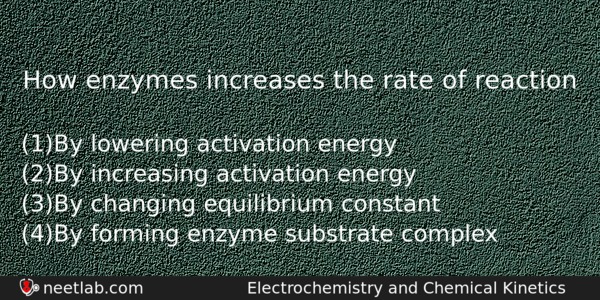| ⇦ | 
| ⇨ |
How enzymes increases the rate of reaction
Options
(a) By lowering activation energy
(b) By increasing activation energy
(c) By changing equilibrium constant
(d) By forming enzyme substrate complex
Correct Answer:
By lowering activation energy
Explanation:
No explanation available. Be the first to write the explanation for this question by commenting below.
Related Questions: - Caprolactum is the monomer of
- In the case of alkali metals, the covalent character decreases in the order
- n-Butane and isobutane are
- Which of the following is dihydric alcohol
- Which of the following is a basic dye
Topics: Electrochemistry and Chemical Kinetics
(87)
Subject: Chemistry
(2512)
Important MCQs Based on Medical Entrance Examinations To Improve Your NEET Score
- Caprolactum is the monomer of
- In the case of alkali metals, the covalent character decreases in the order
- n-Butane and isobutane are
- Which of the following is dihydric alcohol
- Which of the following is a basic dye
Topics: Electrochemistry and Chemical Kinetics (87)
Subject: Chemistry (2512)
Important MCQs Based on Medical Entrance Examinations To Improve Your NEET Score
18000+ students are using NEETLab to improve their score. What about you?
Solve Previous Year MCQs, Mock Tests, Topicwise Practice Tests, Identify Weak Topics, Formula Flash cards and much more is available in NEETLab Android App to improve your NEET score.
Share this page with your friends

Leave a Reply